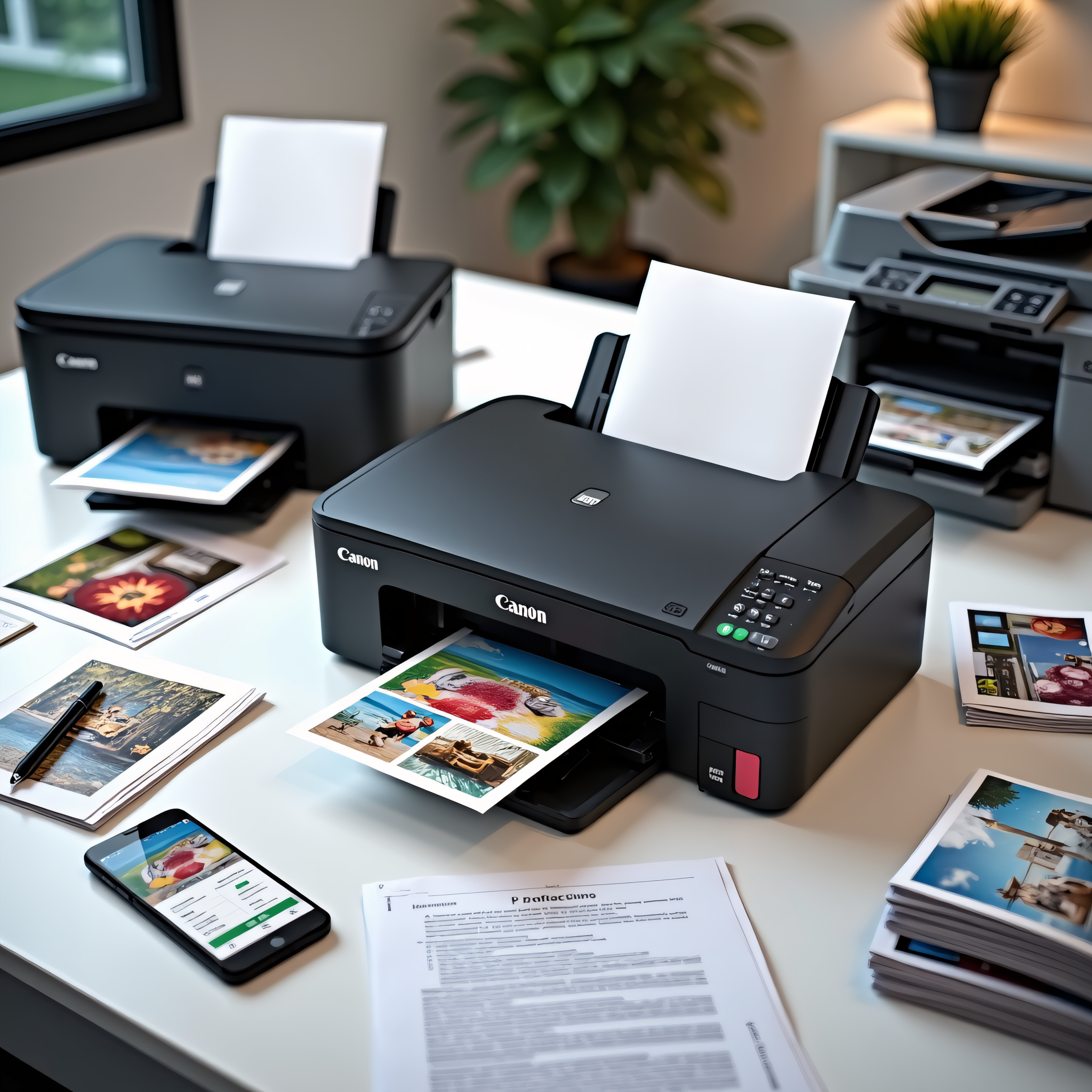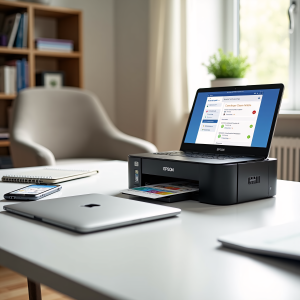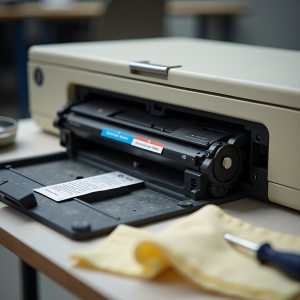estimated reading time: 7 minutes
Understanding Canon Printer Types
Canon offers three primary printer types: laser, inkjet, and all-in-one, each with its own strengths and weaknesses.
Laser Printers (LBP Series): These printers are known for their speed and efficiency, making them ideal for high-volume printing tasks. Laser printers generally boast a lower cost-per-page compared to inkjet printers, making them a more economical choice for businesses or individuals with significant printing needs. The initial purchase price of a laser printer is typically higher than that of an inkjet printer. Average price ranges for Canon LBP series printers vary, but generally start around $100 for basic models and can extend to several hundred dollars for advanced models with more features.
Inkjet Printers (PIXMA & G Series): Inkjet printers excel in producing high-quality photo prints, making them popular among photography enthusiasts and home users. While the initial cost of an inkjet printer is often lower than a laser printer, the ongoing cost of ink cartridges can be significant, especially for high-volume printing. Canon’s PIXMA series offers a wide range of inkjet printers, while the G-series focuses on refillable ink tanks for cost savings. Average price ranges for Canon inkjet printers start as low as $50 for basic models and can reach several hundred dollars for advanced models with features like wireless connectivity and duplex printing.
All-in-One (MF Series): Canon’s MF series combines printing, scanning, copying, and sometimes faxing capabilities into a single device. These all-in-one printers are a popular choice for home and small office users who require a versatile solution that saves space and combines multiple functions. Average price ranges for Canon all-in-one printers are similar to inkjet printers, starting around $70 for basic models and increasing to several hundred dollars for more feature-rich models.
Canon Laser Printer Deep Dive
Let’s delve into some specific Canon laser printer models:
Canon LBP2900b/2900: This entry-level model is known for its simplicity and reliability. It offers a print speed of around 12 pages per minute (ppm) at a resolution of 600 x 600 dpi. Paper capacity is typically limited, and it lacks advanced features like duplex printing or wireless connectivity. It’s suitable for basic home or office printing tasks where speed and advanced features are not critical.
Canon LBP6030/6030b/6030w: Stepping up, the LBP6030 series offers faster print speeds (up to 18 ppm) and higher resolution (2400 x 600 dpi). The 6030w model adds wireless connectivity, making it more versatile. While still monochrome, these printers are suitable for small offices with moderate printing volume.
Canon LBP2520/Canon imageRUNNER 2520: Designed for higher volume printing needs, the LBP2520 and its more advanced counterpart, the imageRUNNER 2520, offer significantly faster print speeds and higher duty cycles. The imageRUNNER series typically includes advanced network capabilities for shared printing environments. These printers are suitable for small to medium-sized offices requiring robust and reliable printing solutions.
Source:
Toner costs and yields vary significantly across these models. It’s crucial to research compatible toner cartridges and their page yields to estimate running costs before purchasing. For example, the LBP2900b typically uses a lower-yield toner cartridge compared to the LBP6030, resulting in higher running costs per page in the long run.
Source: https://euroffice.co.uk/help/buyers_guides/ink-cartridges-and-toner
Canon Inkjet Printer Showcase
Canon’s inkjet printers are divided into the PIXMA and G-series.
Canon G-Series (G1010, G1020, G2000, G2010, G2020, G3010): The standout feature of the G-series is its refillable ink tank system. This significantly reduces the cost per page, making it a very economical option for high-volume printing, especially for color prints. Print speeds vary across models, generally ranging from 8 to 10 ppm for black and white and slightly slower for color. Resolution is typically 4800 x 1200 dpi, delivering excellent print quality. The higher initial cost is offset by the significantly lower running costs.
Canon PIXMA MP250/MG2540s/IP2770: These models represent more budget-friendly options, ideal for occasional home printing. They offer decent print quality for documents and photos, but utilize standard ink cartridges, leading to higher running costs compared to the G-series. Print speeds are generally lower than the G-series, and features like scanning are either limited or absent in some models.
Comparing ink costs and page yields is crucial when choosing between these series. While the G-series has a higher initial cost, the refillable ink tanks drastically reduce the long-term running costs [8]. Conversely, the PIXMA series offers lower upfront cost but higher per-page costs due to cartridge replacements [8]. Printhead clogging is a common issue with inkjet printers; understanding cleaning procedures can prevent costly replacements.
Source: https://printbusiness.co.uk/wp-content/uploads/2021/03/PrintBusiness_JanFeb21.pdf
Canon Multi-Function Printer Examination
Canon’s MF series offers a range of all-in-one solutions.
Canon MF3010/MF3010 series: These entry-level all-in-one printers provide basic print, scan, and copy functionality at an affordable price. Print speeds and resolutions are comparable to entry-level inkjet printers. They are suitable for basic home or small office use where a compact and affordable multi-functional device is required.
Canon MF232W/MF244DW/MF240: These models offer more advanced features, including wireless connectivity and mobile printing capabilities. They typically boast faster print speeds and higher scan resolutions compared to the MF3010 series. These printers are ideal for small to medium-sized offices requiring a more versatile and feature-rich all-in-one solution.
Comparing scan resolutions and copy speeds is important when choosing between these models. The higher-end models offer superior scan quality and faster copy speeds. Connectivity options (Wi-Fi, USB, Ethernet) also vary, impacting usability and network integration.
Troubleshooting Common Canon Printer Issues
Paper Jams: Follow the instructions in your printer’s manual to clear paper jams. Typically, this involves opening access panels and carefully removing the jammed paper.
Connectivity Problems: Ensure the printer is correctly connected to your network or computer. Check Wi-Fi settings, USB cables, and drivers. Consult Canon’s support website for troubleshooting specific connectivity issues.
Print Quality Issues: Check ink levels, cartridge alignment, and print head condition. Run print head cleaning cycles as needed. Low-quality paper can also affect print quality.
Error Codes: Canon’s support website provides detailed explanations and troubleshooting steps for various error codes. Refer to this resource for specific error code solutions.
Check out our blog on Canon Printer Support
Choosing the Right Canon Printer: A Buyer’s Guide
Several factors influence the choice of Canon printer:
- Printing Volume: High-volume printing necessitates a laser printer for cost-effectiveness. Low-volume printing allows for the affordability of inkjet printers.
- Color vs. Monochrome: If color printing is essential, an inkjet or color laser printer is necessary. Monochrome laser printers are sufficient for text-based documents.
- Features: Consider scanning, copying, faxing, and wireless connectivity based on your requirements.
- Connectivity: Choose the appropriate connectivity options (Wi-Fi, USB, Ethernet) based on your network setup and device compatibility.
- Budget: Balance initial purchase cost with ongoing running costs (ink/toner).
Conclusion
Choosing the right Canon printer depends on your individual needs and budget. This guide has highlighted the key features and differences between various Canon printer types and models, enabling you to make an informed decision. Remember to consider printing volume, color requirements, features, connectivity, and budget before making your purchase. Visit Canon’s official website for the latest models and detailed specifications. Check out our blog post on The Ultimate Guide to Printers
Source: https://issuu.com/guyanachroniclee-paper/docs/2015-1-11
FAQ
Q: What is the difference between Canon’s PIXMA and G-series inkjet printers?
A: The main difference lies in the ink system. PIXMA printers use standard ink cartridges, while the G-series features refillable ink tanks, resulting in significantly lower running costs for high-volume printing.
Q: Which Canon printer is best for a small office needing both printing and scanning?
A: Canon’s MF series all-in-one printers are ideal for this scenario. Models like the MF244DW offer wireless connectivity and both printing and scanning capabilities.
Q: How can I reduce the running costs of my Canon inkjet printer?
A: Consider using the Canon G-series with refillable ink tanks for significant cost savings. Also, ensure you are using compatible, high-yield cartridges and practice proper printer maintenance to extend the life of your print heads.
Q: What should I do if my Canon printer shows an error code?
A: Refer to Canon’s official support website for detailed explanations and troubleshooting steps related to specific error codes.



